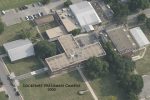After years of reduction, council votes to raise ‘impact fees’ *UPDATED Oct. 7, 2011*
By Miranda Rogers
POST-REGISTER
After years of offering reduced or waived impact fees for new construction, the Lockhart City Council voted on Tuesday evening to approve an increase to those fees – an action the Planning and Zoning Commission and City Planner Dan Gibson have been encouraging for years.
As required by statute, Gibson delivered the requi
red semi-annual report from the Impact Fee Advisory Committee, which has an ongoing role in monitoring and evaluating implementation of the impact fee capital improvement plans, to the council during their regular meeting on Tuesday. The report, Gibson said, showed the current balance of all impact fee accounts is much less than the previous six-month report.
Gibson said Lockhart is the second cheapest city in Texas for road impact fees, due to the fact that Lockhart has historically only charged those fees at 25 percent, while other cities charge 50 percent.
The 25 percent value was meant as a temporary reduction in the rate charged for road impact fees, and the Committee has once again suggested to Council that the maximum allowable amount be charged, effective Oct. 19, 2011.
Mayor Ray Sanders initially showed concern about the pros and cons of changing the fee from 25 percent to 50 percent, Gibson said there was no proof that the fees would encourage or discourage people from moving to Lockhart. In fact, he asserted, the City of Buda has a high impact fee and is seeing significant growth.
On a split vote, the council agreed to increase the road impact fees as recommended. District Three Councilmember Lew White was the only member in opposition, and At Large Councilmember Paul Gomez, who has historically voted in favor of reduced impact fees, was absent from the meeting.
In a return to old business, the council reconsidered an ordinance that would change the firebreak requirements on agricultural property within the city.
During their last meeting on Sept. 20, the council heard a proposed ordinance that would have required doubling the fire break width requirements from 15 feet to 30 feet, which supporters said would allow more time for firefighters to respond.
After hearing valid concerns and input from many property owners that had taken the time to attend the meeting, council decided hold off on a vote until Oct. 4, 2011, with Sanders asking those in attendance to contact City Manager Vance Rodgers regarding any other comments or suggestions.
Rodgers said he received no such contacts, but the property owners attending the Oct. 4 meeting were happy to hear that the current ordinance will remain, and closer attention will be paid to areas in need of enforcement.
In other business, the Council delayed consideration of a proposal to amend the city’s zoning ordinance to allow bars, taverns, lounges and/or dance halls in the Commercial Central Business District (on and around the Caldwell County Courthouse Square).
Because of a delay in a meeting of the Planning and Zoning Commission, the council had no choice but to delay consideration of the ordinance revision. Consideration of the proposal has been scheduled for a special-called meeting on Nov. 16, 2011.
In other news:
Sanders had the honor of presenting several proclamations for the month of October.
The first was to name the month of October as “Domestic Violence Awareness Month.” Domestic violence can take many forms of physical, emotional and verbal abuse, and is used by one person in a relationship to control the other.
The Hays-Caldwell Women’s Center has served Lockhart for 34 years and helped 78 Lockhart residents receive service last year alone. The purpose of the Hays-Caldwell Women’s Center is to create an environment where violence and abuse are not tolerated in the communities they serve. The center provides education, violence prevention services, and crisis intervention to victims of family violence, sexual assault and child abuse.
Representatives from the Center were on hand to receive the proclamation.
The second proclamation named Oct. 17 – 21, 2011, as “Chamber of Commerce Week.” Greater Caldwell County Hispanic Chamber of Commerce representative Alfredo Munoz, said he appreciated the recognition, and on behalf of his organization pledged to “…. keep on plugging on with what we’ve been doing.”
Little Miss CTR Cecilia Amaya was among representatives of the Lockhart Chamber of Commerce who were present to receive the proclamation .
Finally, Sanders also declared the week of Oct. 9 – 15 as “Fire Prevention Week.”
Recognition was given to the Lockhart Fire Department for their work this year and in the past, not only through their assistance with the Delhi and Bastrop Complex fires, but having tamed 360,000 home fires here in Lockhart.
Lockhart Fire Department Chief Jerry Doyle reminded area residents to continue to take precautions to protect their family and homes, and announced that the Department has plans to tour Lockhart’s four elementary schools and one kindergarten to teach the students about fire safety that they can carry with them throughout their lives.
In brief news:
Lockhart EMS Director Aaron Langford approached the council in an effort to acquire new reporting software, and to consider a change from the currently-contracted billing and collections company.
The council approved the purchase of a “street crack sealing machine,” which will help city crews to perform routine and preventative maintenance on city streets. The equipment, which will be purchased from Craftco, Texas, Inc., will cost $46,485.50, and will be paid for using monies from the city’s Transportation Infrastructure Fund.
At Sanders’ request, the council considered appointing either White or District Two Councilmember John Castillo to the General Assembly of the Capital Area Council of Governments (CAPCOG). A split vote on the nomination means the council will put off the decision until a later date, when all council members are present.
The Lockhart City Council traditionally meets on the first and third Tuesday of each month at 7:30 p.m. in the Glosserman Conference Room at Lockhart City Hall. A worksession prior to each meeting begins at 6:30 p.m. All meetings and worksessions are open to the public and televised on Time Warner Digital Cable Channel 10.
**UPDATE**
Clarification
In response to information covered in the article entitled “After Years of Reduction, Council Votes to Raise Impact Fees,” Lockhart City Planner Dan Gibson asked that the following clarifications be offered to the information provided (in Mr. Gibson’s words via email dated Oct. 10, 2011):
“- In fact, the increase only applies to road impact fees. Water and wastewater impact fees have always been charged at the originally adopted maximum allowable amount. The increase in impact fees is only due to the proposed elimination of temporary discounts in the amounts charged for road impact fees. For the past two or three years, road impact fees for commercial uses have been charged at only 50 percent of the originally adopted amount, and road impact fees for all other uses (residential, office, industrial, and institutional) have been charge at only 25 percent of the originally adopted amount.
It’s easy to get confused because the originally adopted amount, itself, is only 50 percent of the actual amount needed to pay for all of the projects in the road impact fee capital improvements plan. The other 50 percent must come from other sources, which is usually tax-supported bonds that are paid for by existing citizens.
So, when the fees are discounted 50 percent, for example, then it’s really 25 percent of the total needed to construct the improvements.
To simplify matters, though, I and the Impact Fee Advisory Committee make it clear to the City Council that when we talk about charging 50 percent or 100 percent, etc., it means 50 percent or 100 percent of the originally adopted maximum amount, while at the same time acknowledging that there’s that other matching amount that must come from other sources.
– The reason for the lower balance in the accounts is that, for the first time, funds were spent on road, water and wastewater projects, thereby reducing the balance of funds left in the accounts.
– The Impact Fee Advisory Committee recommended increasing the road impact fees for all uses to 100 percent of the originally adopted maximum amount.
– A point that the Impact Fee Advisory Committee always makes, including in the report at this Council meeting, is that our combined water, wastewater, and road impact fees for a single-family dwelling are less than the water and wastewater impact fees, alone, in most other cities that do not charge a road impact fee. Also, the article failed to mention that the Council’s vote was simply direction to staff to prepare the ordinance amending Section 31-19(b) of the Impact Fee Ordinance. It did nothing to actually change the ordinance. The final vote adopting the ordinance will be on their Oct. 18 agenda.”
Editor’s note: A factual error presented in the article suggested Mr. Gibson stated that Lockhart is the “second-cheapest city in Texas for impact fees.” In fact, the information presented to the council reflected a survey of only seven cities in Central Texas, with regard to residential impact fees alone. Lockhart is one of three cities included in the survey that charges residential road impact fees, and has the second-lowest impact fee total.




I have a quick question for Mr. Gibson? Of the seven cities, which were they and were they reflective of population or other comparable means to Lockhart?